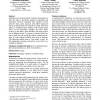166 search results - page 14 / 34 » Identifying Linear Causal Effects |
COLCOM
2005
IEEE
14 years 1 months ago
2005
IEEE
Using a combination of machine learning probabilistic tools, we have shown that some chemistry students fail to develop productive problem solving strategies through practice alon...
HAPTICS
2009
IEEE
14 years 2 months ago
2009
IEEE
This paper reports on two experiments we conducted to look at how to design effective linear and circular apparent-motion displays. Using a two-tactor array on the upper arm, the ...
JMLR
2010
13 years 2 months ago
2010
L1 (also referred to as the 1-norm or Lasso) penalty based formulations have been shown to be effective in problem domains when noisy features are present. However, the L1 penalty...
CHI
2005
ACM
14 years 7 months ago
2005
ACM
Authoring tools routinely include a timeline representation to allow the author to specify the sequence of animations and interactions. However, traditional static timelines are b...
JSS
2006
13 years 7 months ago
2006
This paper describes an approach to the feature location problem for distributed systems, that is, to the problem of locating which code components are important in providing a pa...

